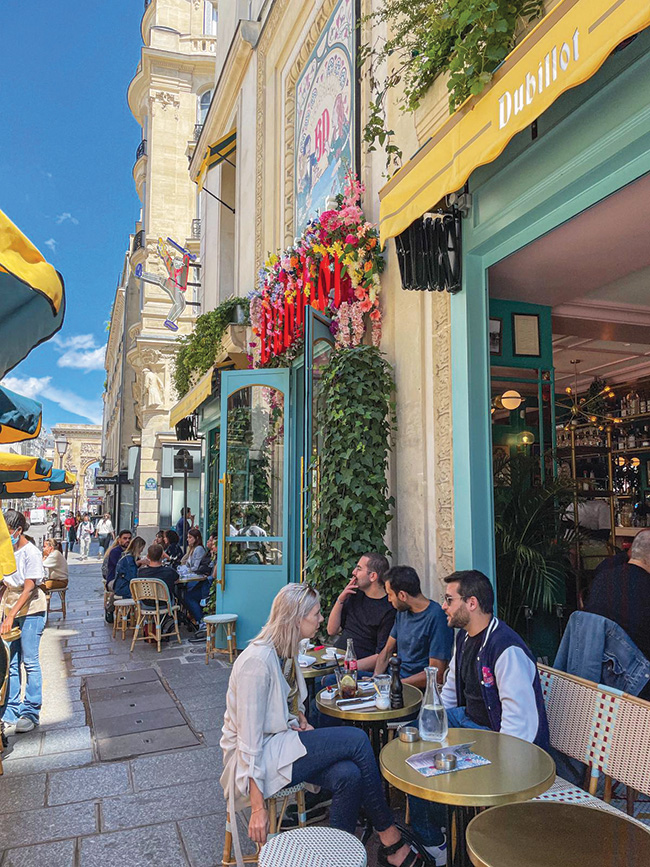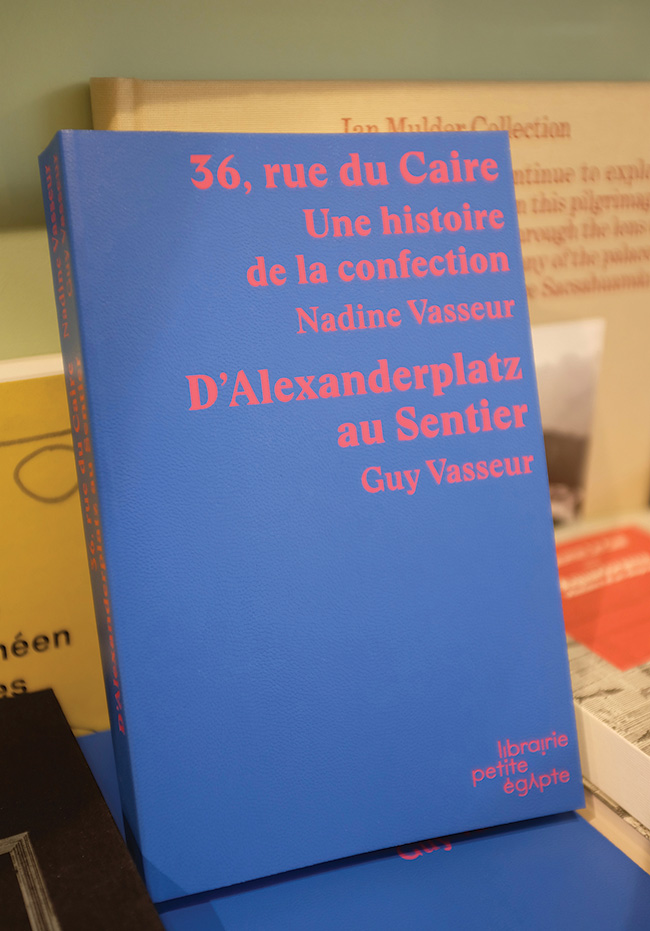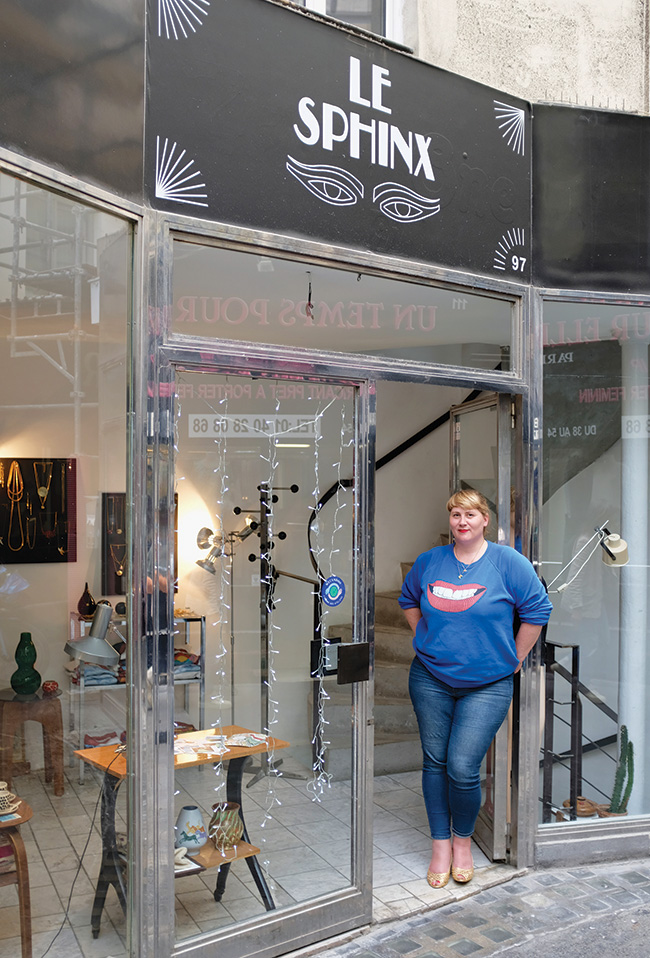Parisian Walkways: Le Sentier

Jeffrey T Iverson visits Le Sentier, Paris’s historic garment district, a neighbourhood which has been all too often neglected but which is finally enjoying its share of the limelight.
The neighbourhoods of central Paris have always ranked among the most cherished in the city for property investors and tourists alike, from Île Saint-Louis to Saint-Germain-des-Prés. Yet one neighbourhood at the heart of the city has always been snubbed as the odd one out – le Sentier, a tangle of streets in the 2nd arrondissement, bordered on the north and south by Boulevard de Bonne Nouvelle and Rue Réaumur, and on the east and west by Boulevard de Sébastopol and Rue Montmartre. Home to a notorious slum in the 17th century and transformed into a bustling garment district by the 19th century, the Sentier has long been disregarded by many Paris lovers as a gritty enclave of cacophonous textile workshops and traffic jams. Yet today that’s changing.
As segments of the textile industry have begun to leave Paris, a wave of French start-ups and dot-com companies has moved in, while former workshops have been transformed into chic loft apartments. A host of new restaurants, galleries and boutiques has opened to satisfy a growing clientele of cultured, curious and affluent Parisians. Now with hip new hotels popping up, tourists are coming to the Sentier for the very first time and discovering a new face of the City of Light – a fascinating quartier with a tradition of go-getter entrepreneurship which has made it one of the most dynamic reservoirs of trendsetting businesses in Paris.
When visitors would step off the Metro at the Sentier stop a decade ago, it was usually to take a stroll south down the Rue Montorgueil, an historic, postcard-perfect market street beloved of foodies. Yet today, many of those stepping off the Metro are walking north instead, across Rue Réaumur and up Rue des Petits Carreaux into the Sentier. There, the narrow, cobblestone streets are lined with shops, bars and restaurants, mostly recently opened. People dine and sip drinks in the sun at tables covering the square between Rue des Petits Carreaux and Rue d’Aboukir, overlooked by a towering wall of greenery known as the Oasis of Aboukir – a five-storey vertical garden created in 2013 by the botanist/artist Patrick Blanc to cover what was once a sad façade of bare cement.
In this once sleepy corner of the Paris garment district, the signs are everywhere that a dynamic change is afoot. Take the lively bookstore Petite Égypte, founded in 2015 at 35 rue des Petits Carreaux. “The opening of a bookstore in a neighbourhood is generally a good indicator of its gentrification,” laughs founder Alexis Argyroglo. “And today in the Sentier, a demographic, social and professional evolution is taking place which has drawn a new population with significant financial and cultural capital.” That population provides Petite Égypte with a large, privileged clientele, but it’s not the only reason he chose to open a shop here. “I’m fascinated by the social, industrial, and commercial history of the Sentier, yet it’s actually been the subject of very little research,” he says. “In coming here, I wanted to help to celebrate this history, to see it recognised as a unique part of French heritage.”
Petite Égypte launched a writer’s residence programme and invited the historian Manuel Charpy to take a fresh look at the neighbourhood’s past, created a newsletter to present newly discovered archives, and published a new edition of the only authoritative history of the Sentier written to date – 36 rue du Caire by Nadine Vasseur, a journalist whose father, a Holocaust survivor, founded a factory in the Sentier. As Vasseur recounts, the Sentier as we know it first took shape in the 17th century. In 1634, a medieval wall circling Paris was demolished and replaced by two streets which still run diagonally across the neighbourhood today – Rue d’Aboukir and Rue Cléry. Soon after, a notorious slum known as the Cour des Miracles – described by Victor Hugo as “a city of thieves, a hideous wart on the face of Paris” – then situated between today’s Rue Dussoubs and Place du Caire, was razed to the ground as well. These changes led to a real-estate boom, with aristocrats and notables building lavish hôtels particuliers throughout the area. A prime example is the splendid 17th-century Hôtel de Saint-Chaumond, visited today through a short passageway at 226 rue Saint-Denis.

The 17th-century Hôtel de Saint-Chaumond
In 1723, the powerful Compagnie des Indes, founded in 1664 to import riches from Asia, was established nearby on Rue d’Aboukir. Their clientele included the mistress to Louis XV, Madame de Pompadour, who lived at 33 rue du Sentier. As the best-preserved area in Paris from the Louis XIV and XV periods, numerous mid-17th century buildings remain in the Sentier, like the Pointe Trigano, the narrowest apartment building in Paris, situated at 98 rue de Cléry. Napoleon also left his mark on the neighbourhood, by commemorating his campaign in Egypt through the renaming of several of the Sentier’s streets (Alexandrie, Aboukir, Nil, Caire), including the city’s first covered shopping arcade, Passage du Caire, whose ‘spider web’ glass-paned roof has enchanted visitors since 1798.

Rue du Sentier © JT Iverson
In the 19th century, the founding nearby of the Bourse, Paris’s stock exchange, saw this residential district transform into a primarily commercial one. The bourgeoisie left, and by the late 1800s the neighbourhood was becoming a vibrant working class area, thanks to waves of immigrants fleeing conflicts around the world, from Alsace to Turkey to Russia. For these destitute new arrivals, nowhere was it easier to find work than the garment industry, requiring only a sewing machine and some cloth to get started. Over time, the Sentier became seen as a kind of immigrants’ El Dorado, a reputation fed by stories like that of Mehmood Bhatti, who arrived in the Sentier in 1978 as a penniless Pakistani immigrant and eventually became a millionaire prêt-à-porter baron. In fact, by 1989, 5,000 or so businesses in the Sentier were annually earning a collective 55bn francs, or nearly $11bn.

Le Sentier is a buzzing neighbourhood
Digital Revolution
But in the 1990s the industry began to change. Big chains like Gap and Zara arrived on the scene and started manufacturing their own models. Then in 2001 China joined the WTO and its textile industry began exporting to Europe. The Sentier would never be the same. The big wholesalers folded or moved out to the Paris suburbs. And yet the Sentier’s garment industry didn’t die: historic manufacturers like Atelier Boivin, specialising since 1920 in silk ties and bow ties, endure today, while successful Sentier-born brands like Sandro and Maje, along with many smaller designers, show there is still a future in the neighbourhood for quality-minded manufacturers producing “accessible luxury”. But textiles are no longer the only game in the Sentier.

Relax at Brasserie Dubillot © LouLeBloas5
Starting in the late 1990s, internet start-up companies began setting up in the Sentier, attracted by the fibre optic broadband networks already installed nearby for the AFP and the stock exchange. The arrival of Yahoo! and lastminute.fr and many more earned the neighbourhood the nickname Silicon Sentier. Yet the area’s allure for creative wheeler-dealers goes beyond its internet access. “The Sentier is a place that has always drawn pioneers, and it’s still a bastion for avant-garde entrepreneurs today,” says Sandra Mielenhausen, co-founder of Plaq (4 rue du Nil), the first bean-to-bar chocolate maker in Paris. “From the founders of the new Hôtel du Sentier to the chef of the (neo-Californian cuisine) restaurant Echo, this neighbourhood is a microcosm of people who aren’t afraid to innovate and offer Parisians something completely new.”
Founded in 2019, Plaq is the most recent arrival on Rue du Nil, a once-deserted street which became a forward-thinking foodie heaven. Today the Sentier is teeming with innovative eateries, from the trendy Balkan café Ibrik (9 rue de Mulhouse) to Maafim (5 rue des Forges) by Israeli chef Yariv Berreby, to Pantagruel at 24 rue du Sentier, where chef Jason Gouzy’s culinary revisiting of traditional French dishes earned him a Michelin star in 2021. Similarly, at 222 rue Saint-Denis, the ebullient Brasserie Dubillot was created out of a desire to inject the waning institution of the French brasserie with a new lease of life. Other addresses offering fresh ideas include bars like Hoppy Corner (34 rue des Petits Carreaux) and the DIY brewery Brew Unique (1 rue des Jeuneurs) which are bringing the craft beer revolution to Paris, and La Cave du Sentier (33 rue d’Alexandrie), which is acquainting oenophiles with the beauty of the world’s newest wine style – skin contact or ‘orange’ wine.

Wilo & Grove Gallery © JT Iverson
Artisanal Flair
Of course, food and drink aren’t the only things being revisited in the Sentier. In 2013, Morgane Sézalory, founder of the 100% online pret-à-porter brand Sézane, opened l’Appartement Sézane (1 rue Saint-Fiacre), the first boutique in Paris where shoppers come only to try on clothes before ordering them digitally. In the Passage du Caire, the trendsetting jewellery maker Alice Hubert has opened a workshop-boutique, hoping to inspire other artisans to move into this historic arcade. And at Wilo & Grove (40 rue des Petits Carreaux), former Christie’s auction house art experts Fanny Saulay and Olivia de Fayet created what they call the “next-generation art gallery” in a bid to defend brilliant under-the-radar contemporary artists and keep prices fair for everyone, while presenting artwork in an uncommonly relaxing environment – all in the same building which features the stunning Oasis of Aboukir green wall. “When you see how the Sentier is reinventing itself today, it really refutes this notion we hear that Paris has lost its dynamism,” says Olivia. “That’s why we fell in love with this neighbourhood, it’s a place that seems destined to evolve without end.”

The Oasis of Aboukir by botanist/artist Patrick Blanc © JT Iverson
With so many attractions, the Sentier has become a destination for in-the-know travellers today. Several stylish hotels have been created for them, from Hôtel Edgar (31 rue d’Alexandrie) to The Hoxton (30-32 rue du Sentier), housed in a sumptuous hôtel particulier once home to an advisor to Louis XV. Finally, in 2021 an historic building with a truly iconic façade was reopened as the Hôtel du Sentier. The hotel’s façade, decorated with sculpted hieroglyphs and heads of Hathor, is a transporting vestige of the Egyptomania which gripped France in the early 19th century. It boasts four stars, yet founders Charlotte and Samuel Castro instil it with the familial ambience of a provincial guest house. Charlotte admits she’s so at home in the Sentier she rarely leaves. “It’s such a pleasurable place to live. There are busy commercial areas we can visit just nearby, yet when we come home in the evening, it’s so calm here we have the impression we’ve stumbled upon a little hidden square in Provence.” Indeed, spend an evening on Hôtel du Sentier’s charming restaurant terrace on the quiet, tree-lined Place du Caire, while the Egyptian goddess of love, beauty and pleasure gazes down on you from overhead, and you will agree – there is no place in Paris like the Sentier.

Going shopping at Librairie Petite Égypte© JT Iverson
Businesses around Le Sentier
Librarie Petite Égypte
35 rue des Petits Carreaux
Tel. (+33) 1 47 03 34 30
Founded in 2015, this vibrant independent bookstore caters to the Sentier’s wide clientele of creative professionals, schools and families with a vast collection of works for all ages and interests, most of which are carefully curated from small publishers. Its name refers to the Sentier’s many Egypt-themed streets, and the store offers a number of books on the history of fashion and the Sentier.

Wilo & Grove is a delight to visit © JT Iverson
Wilo & Grove
40 rue des Petits Carreaux
Tel. (+33) 1 89 32 96 80
After a decade working at Christie’s, Fanny and Olivia decided it was time the archetypal French art gallery got an overhaul. Out with the white box décor and the snooty reception, they created a gallery as welcoming as your best friend’s apartment, filled with vintage furnishings and an exquisite collection of sculptures and paintings by rising artists at prices for every budget.

Trendsetting jeweller Atelier Alice Hubert © JT Iverson
Atelier Alice Hubert – Le Sphinx
97 passage du Caire
Tel. (+33) 9 54 67 34 83
Ever since stars from Maïwenn to Mélanie Laurent started wearing her creations, Alice Hubert has been one of Paris’s most talked about jewellers. Inspired by jewellery from Egypt to the 1900s, and with a penchant for using saucy bons mots and images to awaken one’s inner femme fatale, Alice’s jewels don’t just catch the eye, they start conversations.

Plaq is one of the most in-vogue chocolate producers in Paris © JT Iverson
Plaq
4 rue du Nil
Tel. (+33) 1 40 39 09 54
Until Sandra and Nicolas opened Plaq in 2019, the notion of bean-to-bar chocolate was foreign in France. Today, Plaq is one of the most in-vogue chocolate producers in Paris, supplying Michelin-starred chefs and welcoming throngs of foodies to their factory boutique to taste Plaq’s pure expressions of rare cacao beans, both in bars and bonbons, and in divine desserts and chocolat chaud.

La Cave du Sentier is a treat for the senses © JT Iverson
La Cave du Sentier
33 rue d’Alexandrie
www.lacavedusentier.com
The founders of this charming wine shop created it in 2021 to bring natural wine to the heart of the Sentier. With a collection of cuvées to conquer any natural wine sceptic, from Bordeaux by Château Massereau and Burgundy by Domaine Vini Viti Vinci, to Crozes-Hermitage by Dard & Ribo, plus a stunning selection of skin contact/orange wines and lively evening tastings, it’s mission accomplished!

Brasserie Dubillot has rebooted the concept of the brasserie © JT Iverson
Brasserie Dubillot
222 rue Saint-Denis
Tel. (+33) 1 88 61 51 24
Situated on an historic street that had fallen into decline in recent years, this ebullient restaurant represents a revival not only for the Sentier but for the French brasserie itself, an institution whose reputation had suffered of late. With classic recipes revisited with farm-fresh produce and a twist, plus chic and spacious rooms and a warm and attentive staff, Dubillot is the brasserie 2.0.
From France Today magazine
Lead photo credit : Book a stay at the Hôtel du Sentier
Share to: Facebook Twitter LinkedIn Email
More in Le Sentier, Paris, Parisian Walkways
Leave a reply
Your email address will not be published. Required fields are marked *




REPLY
REPLY
REPLY